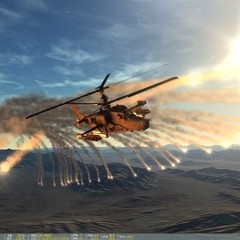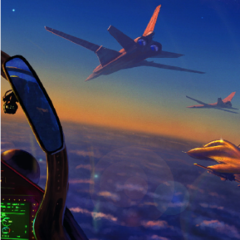-
Posts
2774 -
Joined
-
Last visited
-
Days Won
1
About Swift.
- Birthday 02/26/1999
Personal Information
-
Flight Simulators
DCS
-
Location
London, UK
-
Interests
DCS, Reading about DCS, Thinking about DCS, Talking about DCS
Recent Profile Visitors
13799 profile views
-

Help getting highest INS accuracy for pre-planned popups
Swift. replied to Nealius's topic in DCS: F-16C Viper
Just to put some visual examples up for everyone: Clip showing HUD FIX used whilst GPS is active. It can be seen that the jet doesn't take the full update because, as vader says, its just feeding into the kalman filter and so is blended into the existing solution. Clip showing HUD FIX used without GPS. It can be seen that the jet takes the full update and that FIX is working as first demonstrated in Wags' video. Clip showing a 5x time accelerated 1hr orbit of a target. It can be seen that the inertial position varies from the true position as expected, but it can also be seen that the GPS is holding the inertial solution roughly on the true position. The maximum error observed was about 18m and was seen only briefly. For 90% of the time the inertial solution was within 10m of the true position. Giving an approximate CEP90 of 10M/33ft horizontally. I would love to see if anyone has a track/video of this alleged 200ft disagreement between inertial and true position. As I haven't been able to reproduce that condition. -
Alright, I'll try and see if I can replicate this. Thanks for the info
-
Do we know what the precise mechanism of this bug occurring is? I've seen it happen myself but seemingly quite randomly. Is it when any new PPLI is created after your own jet has started up? ie if a player joins after you?
-
The interesting question would be whether that switch controls receiver functions or just the transmission power. Because false alarms are a processing function on the received radiation. So even if nothing is being transmitted, so long as the receiver is still receiving noise itll still show false alarms.
-

HMD - Why can't HAFUs be displayed outside the small central area?
Swift. replied to Callsign JoNay's topic in DCS: F/A-18C
https://www.globalsecurity.org/military/library/policy/navy/ntsp/jhmcs-d_2002.pdf I think this will show what I'm talking about. -

HMD - Why can't HAFUs be displayed outside the small central area?
Swift. replied to Callsign JoNay's topic in DCS: F/A-18C
As I recall the uplook reticules are a different projector. Which is why they never change shape or size. Only turn on or off. -
Do you know which F-16 manual you saw that in? The ED one doesnt seem to describe that behaviour.
-

user error CCRP / GPS navigation not working?
Swift. replied to Homer79's topic in Bugs and Problems
I'll need to sit down and run some tests myself then. He executed a 4 minute test, which is not exactly long enough to see a trending behavior over time. Especially considering the first minute is spent acquiring GPS signals. Do this test yourself, put yourself in an orbit for a long enough time, lets say 45 mins. And observe how the positional error never exceeds a certain amount but rather wonders around the true location. -

user error CCRP / GPS navigation not working?
Swift. replied to Homer79's topic in Bugs and Problems
The GPS is fixing the drift, its just the GPS is noisy enough that it still induces errors. I've been trying to find some videos or such of an equivalent situation in real life so we can report any errors in magnitude of the effect. But pretty much everything I find is for an EGI jet, which is clearly going to perform better than what we have. -
I'm not ED, I'm just trying to explain to you what is happening in the SIM because you appear to have questions. The decision between CAT I and III is not purely weight based. When you look at some references for this, you'll see that there are odd behaviours with different combinations. ie TGP+CL tank is CAT III, TGP+Wing tanks is CAT I. I appreciate that it's confusing, which is why I tried to help out by making that flow chart to clear up what it seems is happening in the sim.
-

user error CCRP / GPS navigation not working?
Swift. replied to Homer79's topic in Bugs and Problems
@bladewalker Remember in you testing that FA-18 hasn't received the new GPS simulation yet (unless I've missed something in the changelog). So if will for sure behave differently to F-16. Also remember that our FA-18 should have a full blown EGI, rather than the 'rudimentary' INS+GPS that our F-16 should have. So even when both are fully modelled, they shouldn't be behaving identically. -
To my knowledge, the purpose of the CAT thing is an aerodynamic limitation, not a mass or G limitation. Which is why it limits AOA and roll rate, not max G. So that the bags weigh more than the harm is meaningless. The 4 sidewinder loadout you have is interesting, because I'd have expected that to be CAT I as per the tested logic. Perhaps its not '6 AAMs' but 'AAMs on all the underwing pylons'. And as for the last image, you don't have wing bags loaded. So as per the logic I posted previously, that makes it CAT I. Please provide any tracks you have of that 'firing 2 AAMs' occurrence you mentioned. I would be curious to see if the missiles being fired are from the wingtips or from the pylons.
-
Ah I see, so you are saying: 2 bags with nothing else = CAT I 2 bags with AA weapons = CAT III My understanding is the logic between I and III is more complex than just bags and bombs = III. So it would be good to know what specifically you are loading on the jet. For example 6 amraams and two bags would be CAT III, but 2 amraams and 2 bags would be CAT I. Edit, did some testing in DCS and this seems to be the logic for warning light illumination:
-

user error CCRP / GPS navigation not working?
Swift. replied to Homer79's topic in Bugs and Problems
It works, but like all measurements there are tolerances. You can't expect to be hitting the exact atom you planned for, IRL or in DCS.









